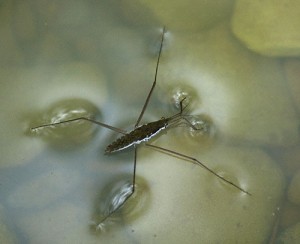by Kelly Harris
As the sun filtered through the leaves warming my back and the cool water flowed around my ankles, I stooped to watch water striders dance along the surface of the stream – this was a common occurrence in my childhood. I grew up on a 400-acre dairy farm that has woods with a spring feed stream flowing through it. I would spend all my free time outside and it was here that I my love affair with nature began.
I nurtured this love through school. I earned my Bachelors of Science in Conservation Biology and then a Masters of Environmental Science in Applied Ecology. Now, I work at the Center for Urban Ecology (CUE). I could have gone down a much different path if it wasn’t for all the opportunities I had as a child to explore nature.
However, you don’t need to live out in the boonies or in the woods to experience nature, it is everywhere, even in a city (see Tim’s post for a more in-depth look into the ecology of a city). Along waterways is one of the best places to interact with nature, especially in an urban setting, for waterways are a mecca for wildlife. Waterways provide water, food, shelter, and corridors for wildlife. Indianapolis has a multiple waterways flowing through it that are brimming with life and possibility.
Indianapolis’ waterways have been overlooked and neglected for years. They have been hidden by invasive plant species, used as dumping sites and polluted with sewage. Over the last several years, the Indianapolis community has join together to change the perception and treatment of the waterways through the formation of the Reconnecting to Our Waterways (ROW) initiative.
ROW seeks to make Indianapolis’ waterways a community asset by “helping neighbors strengthen waterways, and in turn, helping waterways strengthen neighborhoods.” ROW is currently focusing on six waterways and their surrounding neighborhoods which are:
- Near Westside & West Indianapolis around White River and Eagle Creek
- Mid-North along the north bank of Fall Creek
- Lafayette Square along Little Eagle Creek
- Midtown along the Central Canal
- Near Eastside along Pogue’s Run
- Southeast along Pleasant Run
ROW takes a holistic approach to its work around Indianapolis’ waterways by integrating six elements. These elements are aesthetics, connectivity, ecology, economics, education and well-being. These elements function as lenses to craft solutions to problems and to developing projects and programs around the waterways. ROW’s holistic approach is essential to making Indianapolis’ waterways vibrant, safe and healthy destinations for people to experience nature in our city.
I feel providing people opportunities to experience nature no matter where they live – be it a city, the suburbs or a dairy farm – is a critical educational and developmental opportunity that could lead to better environmental stewards. As Baba Dioum says:
“In the end we will conserve only what we love; we will love only what we understand; and we will understand only what we have been taught.”
So much of learning is through experience; you can’t learn about nature only through the Discovery Channel. You have to get out in it. Go explore one of Indianapolis’ many waterways and you might just see a heron, turtle or water striders. I have seen them all and more in Indy’s waterways!
Kelly Harris, MSES/ MPA, is an Americorps SPEA-VISTA Fellow at the Center for Urban Ecology.

